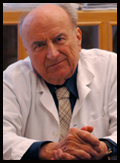The eLitMed.hu medical portal uses computer cookies for convenient operation. Detailed information can be found in the Cookie-policy.
Lege Artis Medicinae - 2005;15(07)
Content
[MANAGEMENT OF CUTANEOUS MALIGNANT MELANOMAS]
[Malignant melanoma, the disease originating from pigment cells of the skin, mucous membrane, eye and rarely from other tissues, shows increasing incidence in the Caucasian population. The Hungarian statistical data correspond with the data of other countries. In the early stages of malignant melanoma surgical removal of the tumor is often curative, but patients with disseminated tumors have a poor survival rate. Regrettably, in Hungary the majority of melanoma patients are diagnosed with advanced tumors, with nodal or systemic metastasis. Physicians working in other fields of medicine have a great responsibility in patient education and in early detection of susceptible pigmented lesions. Diagnosis and treatment of malignant melanoma requires an experienced dermatologist. The clinical diagnosis of melanoma is aided by several new techniques, like digital dermatoscopy. In recent years, surgical therapy of malignant melanoma has changed: today we routinely perform sentinel node biopsy. This type of surgical technique requires experience. In advanced disease the use of chemotherapy and immunotherapy requires onco-dermatological experience. Educating the public and physicians provides the basis for prevention. Survival rate is mainly dependent on the quality of primary care which determines survival rate, therefore it is essential that patients with melanomas are followed up in onco-dermatological centers.]
[THE USE OF GENERIC DRUGS IN THE MEDICAL THERAPY OF EPILEPSY]
[The author demonstrates the relationship between the innovative and generic antiepileptic drugs regarding the clinical aspects. Among the requirements for the registration of generics one can find small differences in the prescribed and the practical levels of bioequivalence. An important but not widely known fact is that these differences can lead to clinically important alterations if the effects of different generics or the effects on high risk patients are compared. While the increasing market of generics is due to economical factors (and rarely due to medical decisions), the safety of the drugs becomes extremely important. From this aspect, special patient populations eg. children, elderly people or patients with multiple illnesses under multidrug treatment are necessarily of greater medical importance. The characteristics of the antiepileptic drugs on the elderly patients, their increased sensitivity to particular adverse events and the possible somatic side effects are discussed in details. The type of epilepsy also has its special characteristics and is important in the choice of the most successful medicine. The development of the antiepileptic drugs shows a positive direction for their efficacy. In the discussion the author points out three main ways for using generic drugs: prescription of generic drug in monotherapy or as an additive in newly diagnosed patients, the exchange of the innovative agent to a generic and the exchange of one generic to another. The author also mentions the legal points and criticizies the regulations available in some countries allowing a free exchange of the bioequivalent drugs without the agreement of the physician or the patient. The final part of the paper reviews the results of the comparative studies on the effects of the generic antiepileptic drugs and the experiences of the physicians of their application based on surveys performed with questionnaires. The data of the literature is compared to the Hungarian methods of application and to his own experience. Recommendations for the application of generic antiepileptic drugs are summarized in „twelve points“.]
[SUBCLINICAL THYROID DISEASES]
[More and more data are indicating that subclinical thyroid diseases can not be regarded as innocuous states. It seems very likely that slight changes in the serum thyroid hormone levels, still within the normal reference range, are sensed beside the pituitary also by other tissues and organs and their function may become abnormal. Considering these problems, it would be advisable to elucidate the proper time to start treatment, whether it is beneficial or not and to determine what the risks are for the applied therapy. Though the recommended guidelines for the management of subclinical thyroid diseases are becoming more and more evident, many questions remain still unanswered. It is not advisable to start an overzelous therapy, however, a too long waiting time for the installation of treatment could also be harmful. Large prospective and randomized trials are needed to clear these questions. This seems to be an urgent task, since due to their high prevalence, subclinical thyroid dysfunction might be regarded as a public health problem.]
[FEMALE SEXUAL DYSFUNCTION]
[Based on the literature data reflecting test results of a high number of patients, the author highlights the frequency of female sexual dysfunction. The aetiology of the disease is partially known. Although diagnostical tests and therapeutical options are limited, it is essential to consider the existence and the high prevalence of female sexual dysfunction and to integrate this into our medical thinking.]
[A NEW SURGICAL TECHNIQUE FOR THE TREATMENT OF SEVERE BRAIN EDEMA OF TRAUMATIC ORIGIN - RESULTS OF THE APPLICATION OF VASCULAR TUNNELS]
[INTRODUCTION - Decompressive craniectomy with durotomy is a well known, although strongly disputed method of treatment in cases of brain trauma, brain swelling and during persisting danger of fatal incuneation. It is not without significance that literature mentions this method only as an option. Although the method successfully diminishes the ICP this can still result in a partial or total lesion occuring in the herniating part of the brain. The actual cause of these symptoms is found in the blockage of the veins and arteries, caused by the shear and the pressure forces between the dural edge and brain tissue. PATIENTS AND METHODS - The new surgical technique consists of the creation of a vascular tunnel around the main cortical veins and the arteries of herniated brain. 36 patients have been operated on with this method. We used historical control (28 patients treated conservatively, 20 patients treated with decompressive craniotomy). RESULTS - A retrospective comparison was performed and the results in connection with the mortality and morbidity rate was promising. CONCLUSION - With the help of our new technique we managed not only to reduce the ICP greatly but we could also avoid further vascular laesion. This is due to the fact that we can assure the circulation and veinous drainage of the herniated part of the brain. This method can be used in any severe edematous state generated by other causes.]
[SOME ETHICAL DILEMMAS OF PLACEBO-CONTROLLED STUDIES]
[The article deals with the question where and when is it ethically acceptable in a randomized controlled clinical trial to give the investigational drug to one of the groups, while placebo to the other. First, it gives a short overview on the origin of the problem and the history of its reemergence before and after the revision of the Declaration of Helsinki 2000. It examines the various forms of placebo use, the pros and cons of its implementation, the international debate before the revision of the Declaration of Helsinki 2000 and the corrections after its acceptance. Finally it declares some principles in connection with placebo controlled clinical trials and examines when such a trial is acceptable in various psychiatric disorders.]
1.
Clinical Neuroscience
[Headache registry in Szeged: Experiences regarding to migraine patients]2.
Clinical Neuroscience
[The new target population of stroke awareness campaign: Kindergarten students ]3.
Clinical Neuroscience
Is there any difference in mortality rates of atrial fibrillation detected before or after ischemic stroke?4.
Clinical Neuroscience
Factors influencing the level of stigma in Parkinson’s disease in western Turkey5.
Clinical Neuroscience
[The effects of demographic and clinical factors on the severity of poststroke aphasia]1.
2.
Clinical Oncology
[Pancreatic cancer: ESMO Clinical Practice Guideline for diagnosis, treatment and follow-up]3.
Clinical Oncology
[Pharmacovigilance landscape – Lessons from the past and opportunities for future]4.
5.













